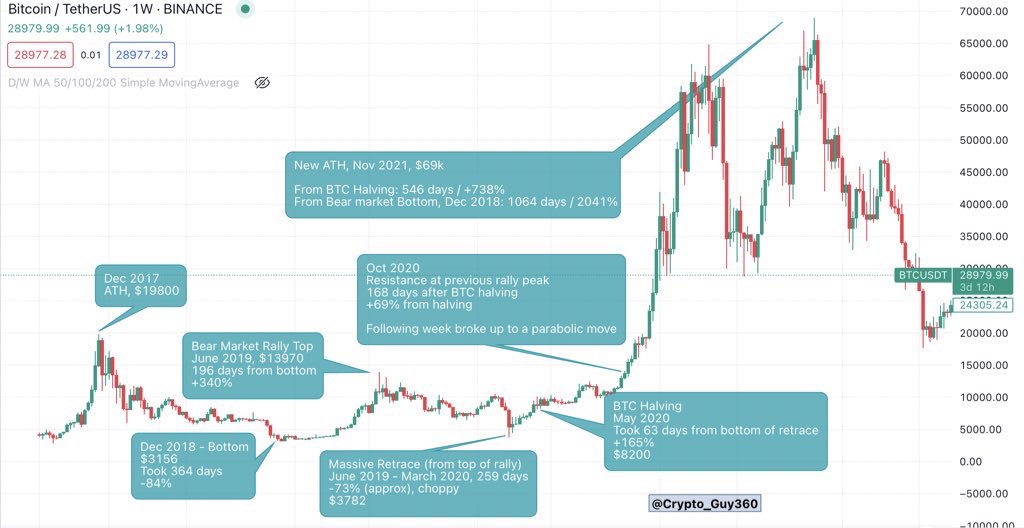🚀 𝐁𝐓𝐂 𝐀𝐧𝐚𝐥𝐲𝐬𝐢𝐬 - 𝐍𝐞𝐰 𝐀𝐓𝐇
2023 will be a crab walk. Volatile, highs and lows.
Don’t get fooled by some thinking that we’ll see a #bullmarket this year, that’s pure Bullshit!
2024 is when the FUN begins. Until then, I’m stacking the lows and looking to sell at… twitter.com/i/web/status/1…
2023 will be a crab walk. Volatile, highs and lows.
Don’t get fooled by some thinking that we’ll see a #bullmarket this year, that’s pure Bullshit!
2024 is when the FUN begins. Until then, I’m stacking the lows and looking to sell at… twitter.com/i/web/status/1…

Why 2024?
That’s when the $BTC halving will take place and after every halving that’s when #Bitcoin goes parabolic and 🚀 to the 🌙
That’s when the $BTC halving will take place and after every halving that’s when #Bitcoin goes parabolic and 🚀 to the 🌙
I’m estimating that we will hit the new ATH about 540/550 days AFTER the $BTC halving.
When is the #Bitcoin halving?
According to @coingecko April 2024 (estimate), 355 days away.
When is the #Bitcoin halving?
According to @coingecko April 2024 (estimate), 355 days away.

According to #binance it’s 20 days earlier, 334 days away.
There will be some discrepancies as the halving isn’t based on an actual date, rather on the block height.
There will be some discrepancies as the halving isn’t based on an actual date, rather on the block height.

What about now until halving?
In the last cycle, after the #bearmarket bottom was in, we saw:
1. A massive rally
2. A massive crash
All BEFORE the BTC halving.
That time span (from bottom to BTC halving) took a total of 518 days.
In the last cycle, after the #bearmarket bottom was in, we saw:
1. A massive rally
2. A massive crash
All BEFORE the BTC halving.
That time span (from bottom to BTC halving) took a total of 518 days.
Assuming we hit the bottom in 21 Nov 2022, and we follow the same data pattern as last cycle, 518 days from the bottom will take us to 22 April 2024 (the halving)
That’s roughly inline with #Binance and #Coingecko estimations.
That’s roughly inline with #Binance and #Coingecko estimations.

Prices start slowly picking up 2-3 months before the actual halving. Do factor that in when planning.
Based on that, I’d say DCA time is from now until Jan 2024.
Based on that, I’d say DCA time is from now until Jan 2024.
When new ATH time?
Based on the last cycle, it took 546 days to peak at the new ATH, AFTER the BTC halving.
Assuming BTC halving takes place on 22 April 2024, then the new ATH will be estimated on 20 Oct 2025
Based on the last cycle, it took 546 days to peak at the new ATH, AFTER the BTC halving.
Assuming BTC halving takes place on 22 April 2024, then the new ATH will be estimated on 20 Oct 2025
This analysis is based on historical data and there is room for error. It’s not an exact science, but often historical data does seem to rhyme!
It’s not financial advice so don’t max out a loan and Fck yourself up! Use this as a guide and cross reference with others.
It’s not financial advice so don’t max out a loan and Fck yourself up! Use this as a guide and cross reference with others.
Thank you!
Please like, follow and RT 👊
Share with others and prepare yourselves for the life changing GAINS to come! 🚀 🔥
#crypto #cryptomarket
Please like, follow and RT 👊
Share with others and prepare yourselves for the life changing GAINS to come! 🚀 🔥
#crypto #cryptomarket
• • •
Missing some Tweet in this thread? You can try to
force a refresh

 Read on Twitter
Read on Twitter







